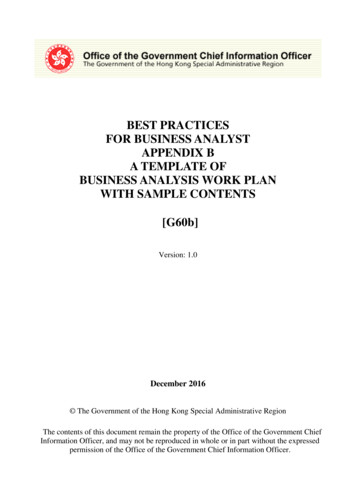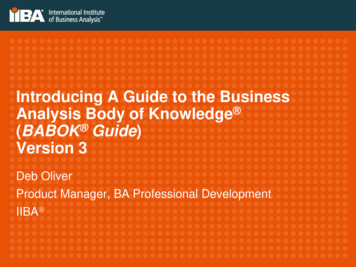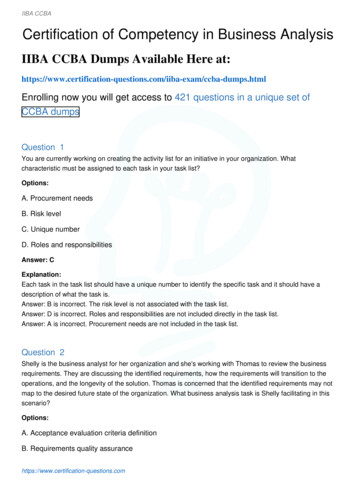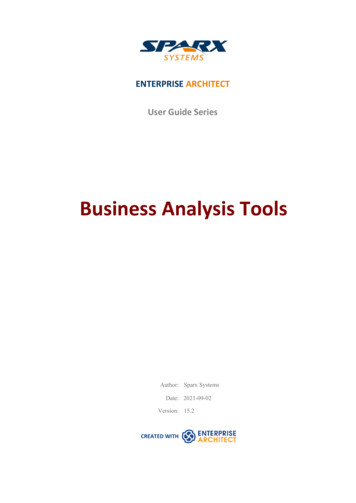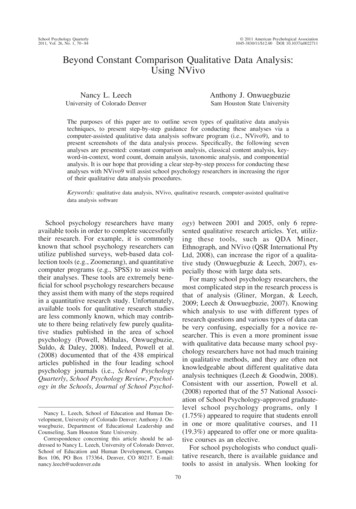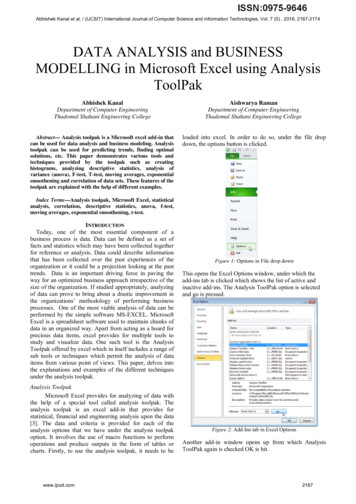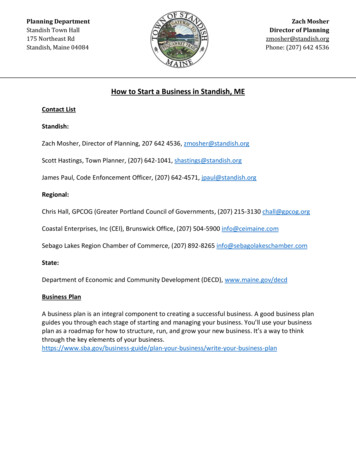
Transcription
AN ANALYSIS OFBUSINESS THROUGHSOCIAL MEDIAMaster’s (One year) thesis in Informatics (15 Credits)Keshav Reddy Karnegari (S101646)Vikram SaiPrasad Karnam (S101645)Gayasuddin Shaik (S101402)Namn 12013MAGI07Namn 1Namn 21
Title: An analysis of business through social mediaYear: 2013Author/s: Keshav Reddy Karnegari (S101646)Vikram SaiPrasad Karnam (S101645)Gayasuddin Shaik (S101402)Abstract:In recent years social media has become ubiquitous and necessary for socialnetworking and content sharing. Social media reached a stage where its impact is beingfelt by larger organizations that exist today. It has become necessary for the organizationsto re-examine their existing business processes and formulate new business processes tocompete in the globalized markets. In our paper we are going to deal with issues like howthe social media affect the business processes and why they are affecting the businessprocesses in contemporary organizations. The success of a business depends on effectiveimplementation of its business processes. So these business processes when beingdesigned several factors are being taken into consideration. Social media facilitates for theconjecture of a mixture of people from different domains for sharing of content, it servesas an important and indispensable factor in defining business processes.Keywords: Social media, Facebook, Twitter, MySpace, Blogging, YouTube, Wikipedia,Podcasting, Business processes.2
AcknowledgementsBusiness processes through social media is a newfangled trend for today’s businesses. Associal media constitutes a rich pool of information, with successful implementation ofnew strategies, methodologies. Businesses can gain a great worth from social media andmoreover this area of study lies within the limits of field of informatics. Our thesis is alittle contribution to the research that is being performed within the area.We would like to thank Anders Hjalmarsson for his great support throughout the completeresearch process.We are thankful to all the participants in our empirical survey and helped us through theinterviews for making the empirical survey success.Borås, October 2013Keshav Reddy KarnegariVikram SaiPrasad KarnamGayasuddin Shaik3
Contents123INTRODUCTION . 61.1Background . 61.2Statement of problem . 81.3Purpose of the study . 91.4Research questions . 91.5Target group . 91.6Delimitations . 101.7Expected outcome . 101.8The author’s own experience and background . 101.9Thesis Outline . 11RESEARCH DESIGN . 122.1Research perspective . 122.2Research strategy . 132.3Data collection procedures . 142.4Data analysis procedures. 172.5Strategies for validating findings. 182.6Result Presentation Method . 18THEORETICAL STUDY. 193.1Key concepts . 193.2Subject areas relevant for the research. 193.3Previous research . 203.4Relevant literature sources . 203.5Social Media . 203.5.1Business Processes .213.5.2Business processes and its components: . 233.5.3BLOGS: . 303.5.4How Twitter Is Effecting Customer Relationship Management: . 323.5.5LinkedIn to the business world: . 343.5.6How MySpace is used by business: . 353.5.7Facebook: . 373.5.8What Skype can teach about business? . 433.5.9Podcasting: . 443.6Summary of theoretical findings . 464
3.7 Arguments for an empirical study. 474. EMPIRICAL SURVEY . 484.1 Purpose . 484.2 Sampling . 484.3 Questionnaire presentation: . 494.4The interviews: . 505 ANALYSIS AND RESULT. 536 DISCUSSION. 556.1 Conclusion . 556.2 Implications for Informatics . 566.3 Method evaluation . 566.4 Result evaluation . 566.5 Possibilities to generalize . 576.6 Ideas for continued research . 577.BIBLIOGRAPHY . 598.APPENDICES . 63Figures:PageFigure 1: Social Media Marketing for Business . . 8Figure 2: Thesis Outline . . . .11Figure 3: Steps showing the questionnaire procedure . . .16Figure 4: Various business processes social media is used for . 21Figure 5: Tweets with links versus RT . . .33Figure 6: Social media traffic changes . 365
1INTRODUCTION1.1BackgroundTim O‟Reilly (2005) developed Web 2.0 as it consists of online activities. The user cancontribute and also can create content. Examples: Wikipedia Online advertisements, andBlogs. The advent of social media and Web 2.0 the business world is looking into newplausible ways for engaging with the current and potential customers. With social media,e-Businesses can capture plenty of available useful information. (O‟Reilly, T, 2005)Social media are commonly made a conceptual connection with social networks. Withthriving in technology and the growth in digital media usage (Morrison & Cheong, 2008),advertisers are searching new ways to grasp consumers. Numerous studies point out anincrease in social network usage (Goldsborough, 2009). While young people significantly25 to 34-year-old were first and foremost users of social networks and white-collarprofessionals to use these (Kim, 2008). Corresponding to an article published byeMarketer on social networking activities of the US, many companies use Facebook andsocial network sites. 29% social networking tools to manage or build their brand, 14% ofcompany CEOs were on Twitter, and 13% posted corporate videos on YouTube,(Delloite, 2009) 31% company CEOs were on Facebook. This survey exhibits some of thenew way points businesses can utilize social media platforms for advertising andpromotional purpose beyond traditional online banner advertisements. Each determinedattempt represents companies’ desire and zeal to not only gain awareness, but alsointeracts with consumers on a deeper, more personal effecting degree.Studying social media is a significant way because consumers interact with theseplatforms differently than traditional media. Social media encompasses an inherent shiftof informational power from the advertiser to the consumer, in which consumers decidewhich content to ignore and which to pass along to others in their network. Many considerthis sharing of online content as powerful as word of mouth marketing.Study by the Nielson Co. in 2008, revealed that 78 percent of the consumers are said to becredible upon the opinions of their peers rather than advertising or all other sources ofinformation. And moreover it revealed that the companies that are not ready to heed the6
customers voices or opinions about losing their customers and also about their prospectsto those that.These are the evidences which give our claims on social media:Move over, emailThe use of social media now surpasses email as the most popular Internet Activity,according to a March 2009 Nielsen Co. study.Social media is not exists for the young:According to April 2009 statistics from Facebook, the fastest growing demographic onthat site today is users 35 and older.Embracing Social Media to Provide Next-Generation Customer Service:As per the September 2008 Gartner report “The Business Impact of Social Computing onCRM Processes,” Michael Maoz writes, “To a greater extent than ever, customers areforming Opinions, seeking information, sharing experiences and creating content onsocial networking sites that are outside the enterprise’s control. The customer experienceis twisted together tightly with the organization and its employees, but the sharing ofthese experiences is wide ranging, and few enterprises entirely, outside of their control.”In-order to get some influence over how the customer led conversations is to involve inthe customer conversations actively and thereby identify the bottlenecks and areas wherethe brand or company failing to heap up good name. By this the organizations can restorethe brand name and strengthen their brand value and gain customer satisfaction bystraightening the deviations or glitches either in products or in the services. We will be asight into different and several configurations of social media and we will be emphasizingthe significance of social media in various fields of interest, significant business. As themain purpose and objective of any business processes involves in casting an output thathas some value to the producer. As social media draw in a various individuals whocomprises of customers, producers and future potential customers, management,observers etc. there is plentiful of unstructured information. Our triumphant depends on7
how well we can use this data for business determination. According to Forrester (2012)research, the sales of software to run corporate social networks will grow 61% a year andbe a 6.4 billion business by 2016.As the field of informatics deals with how Information technology affects the businessand ethical aspects that are needed to be take careful insight while designing andimplementing an information system. Here in our paper we are dealing with how thesocial media is going to affect the business processes and why it’s affecting thecontemporary business organizations.Figure 1: Social Media Marketing for Business (eMarketer, 2008)1.2Statement of problemA business in order to grow in the process, develop and to provide a better serviceto the people there must be an involvement of the people they may customers or critics orfinanciers etc. With the widespread usage and development of social media where it is8
common articulation point for a variety of people, we can exploit the merits of socialmedia.As it is evident from the statistics given by social media websites about their hugenumber of users there is vast scope for business on social media websites like Facebook,YouTube, Twitter, Wikipedia. In a world of information technology where social mediahas become the day to day essential need and part and parcel of life, we cannot ignore thesignificance of the social media while designing a business process. In our thesis we willbe highlighting how social media will affect business processes of contemporaryorganizations and why it affects business.1.3Purpose of the studyThe purpose of the study is to show how the social media, which is available inquite a different set of ways, creates its impact on the business processes that are nowbeing employed by organizations.1.4 A presentation in clear-cut terms the purpose that guides the researchers. A presentation of motives for this purpose.Research questionsThe research questions that we are going to address in our thesis are:1. How social media affects business processes in contemporaryorganizations?2. Why social media affects business processes in contemporaryorganizations?1.5Target groupThe target group in our thesis are the people who design business processes thathave direct impact on people. This also relates to all the people who are using socialmedia and people or organizations who want to change their business with the help ofSocial media like Facebook, twitter etc.9
1.6DelimitationsThere are areas that are in contact with the research question but we are not goingto deal with them in our thesis. They are Why business processes need to be reengineered? What are the problems associated with the reengineering of the business process? How to evaluate the effectiveness of the reengineered business process?These questions are left out of the research even though they are relevant to our researchquestions.1.7Expected outcomeThe expected outcome will be the demonstration of the impact of social media onthe contemporary organizations, why and how they are affecting is shown by taking theaid of a real-time case study.1.8The author’s own experience and backgroundWe have been using social media like YouTube, Wikipedia, Orkut, Facebook, andTwitter from our past 6 years. I took part in an internship that designed a socialnetworking website. We have navigated through social media pages that have somebusiness value according customer’s perspective as well as producer’s perspective.10
1.9Thesis OutlineFigure 2: Thesis Outline11
2RESEARCH DESIGN2.1Research perspectiveThe main purpose of our thesis is to create theoretical knowledge about socialmedia which is sprawling to every corner of the world and about some ways or measuresby which we can use the rich pool of information or data for businesses. Every researchcan be based on two perspectives i.e. Positivism and Hermeneutics. (Rudestam &Newton, 2001)Our thesis mainly focuses on creating knowledge through analysis. For ourresearch hermeneutics are the most relevant approach because it aims at construing andexplaining meaningful concepts (Gilje & Grimen, 1992). Every conscious act of humansis intentional so by these intentional acts a human constructs his or her own world.(Nordin, 1995 & (Ödman, 2004) There is no general pattern for hermeneutics but theresearcher has to learn from experience. (Benediktson, 1989) Emilio Betti hermeneuticperspective that exists today is not only texts can be a basis for interpretation but alsoother creations. (Benediktsson, 1989) The main aim of the interpretation so to reveal theoriginal intentions of the creator (Benediktsson, 1989; Christensen, 1994)Ricoeur (1974) means that also actions can be interpreted as texts and thesetexts should be regarded as autonomous. Ricoeur (1974) says that, if a person is unable tounderstand the text in itself the person should resort to methods for understanding themeaning of the text by analyzing the structure of the text.Our research mainly involves in the interpretation of the text so as to gainsuccessful results or outcomes. As the management or business eavesdrop the discussionsbetween various users about their brand or an unsatisfied customers the listener or readershould be able to understand the text so as present there with necessary solutions that canhelp the user or customer so that businesses can gain worth from it. As our researchinvolves understanding the users or the customer’s intentions and opinions about thebrands and the feedback of the services and products provided by the businesses we needto analyse the text through which the customer expresses himself in social mediaplatforms. As most of the social media like Facebook, Twitter and online communities12
provide a textual environment for expressing their views, we need to be experts atanalysing the texts. So we choose hermeneutic perspective for our research.There are two approaches for designing the research design perspective they arequalitative and quantitative. Qualitative approach is the set of research techniques inwhich the data is collected or inquiry for the data relevant to a specific case is made froma relatively small group of respondents and not analysed.The research perspective that we are employing here for dealing with the questions of ourthesis is qualitative perspective. We choose a qualitative perspective because we will besubstantiating the aim of our thesis by studying, evaluating a real-time case study. Eventhough, we will be using numbers to show the significance of social media in the presentday business scenario. We have not adopted quantitative perspective because we are notgoing to demonstrate our results or outcome by numbers or statistics. For this reason wehave not taken quantitative approach. We are employing qualitative research for ourstudy.2.2Research strategyThe various research strategies can be adopted for doing the research, exploratory,descriptive, and explanatory.Exploratory studies: Exploration studies are considered when there is less clarity aboutthe situation they are going to consider and also when there is no handful of informationabout how situations are dealt in the past. In situations like this lot of exploration work isdone to gain grips over the situation. (Boris Blumberg, Donald R. Copper & Pamela S.Schindler, 2008).Descriptive studies: In descriptive thesis patterns, trends are observed from the statisticaldata. These are more formalized than the exploratory, and typically structured withclearly stated hypothesis or investigative questions. (Boris Blumberg, Donald R. Copper& Pamela S. Schindler, 2008).The research strategy we are implementing in our thesis is exploratory studies. As thebusiness through social media is a new concept we do not have grips over the situation as13
well as we do not have handful of information on how to deal with these situations. Sowe adopted exploratory studies so that we gained knowledge of our situation by usingquestionnaires and interviews. The case study we are considering here is the Talent Sprintorganization. We will approach the organization management, responsible for the supportof information technology, students using social media and a person from marketingdepartments in the Talent Sprint organization. We will be preparing questionnaires with aset of question s that are helpful in gaining the knowledge about how and why the socialmedia is helpful in assisting several processes such as admission of students fromdifferent locations and recruitment process etc.2.3Data collection proceduresThere are different ways used for data collection and in our research we usedquestionnaires and interviews as tools for data collection procedure. We are collecting thedata in two steps/ways and they are the following: QuestionnaireInterviewsQuestionnaires:A questionnaire is said to be standardized when each respondent is asked with similarquestions as of other respondents. We had planned and designed a standardizedquestionnaire. (Maria Teresa Siniscalco & Nadia Auriat, 2005)More often standardized questionnaire is used to collect information about various aspectsof media, personal interests etc. (Maria Teresa Siniscalco & Nadia Auriat, 2005). MariaTeresa Siniscalco & Nadia Auriat, (2005) has classified structure of questions into threetypes, Closed, Open-Ended and Contingency questions. The internet provides researchersto explore different people in different parts of the world easily, cheaply and quickly. Thequestionnaire is carried by emailing questionnaires to people to be completed and replyback by email. Another way is by asking people to visit the website and fill thequestionnaire. (Oates, 2006) In this study for interviews we have used questionnaire as atool.14
We are using questionnaire as the initial step for the collection of data. We will designthree questionnaires that clearly reflect the functionality of the social media that is beingused by the Talent Sprint organization for business activities. We use first questionnaireto interact with the students who are using the service through social media and secondquestionnaire is for the concerned person responsible for the IT support of the TalentSprint organization and the third is used to interview marketing person of theorganization.The following steps are considered while designing a questionnaire.1. Defining the objectives: The objectives should be defined clearly and properly by theResearcher.2. Select the sample group: Selecting target group is also an important task in the settingof the questionnaire.3. Writing the questionnaire: Prepare the questionnaire based on the objectives of yourresearch.4. Analyzing the responses: Analyze the responses that are given by the people who areparticipating in the questionnaire survey.5. Interpretation of responses: Finally comparing all answers for arriving to the finalresults. Based on this we will be addressing questions like, why social media impactsthe business processes and how it’s affecting.15
Figure 3: Steps showing the questionnaire procedureText Analysis:Text analysis is nothing but extraction of relevant data from research papers, searchinginternet, documents, books etc. After collecting appropriate data for this study later wehave to analyze those collected content and then fetch the exact literature required for thisstudy. (Creswell, 2003)Interviews:An interview is a conversation between two or more people, in which one (interview) willbe asking questions by the other (interviewer). All the interviews were made face to face.Before interviewing the each person we thoroughly went through the answers that he hasgiven to our questionnaire. We also studied about how to conduct interviews and weprepared a perfect structure to perform interviews for our convenience. We did notperform any pilot study before conducting the interviews. Therefore we gave additionalinformation to the respondent’s by explaining some of the concepts that were used in the16
interview structure. Before going to conduct the interview we intimated to the participantsabout our research study, and what kind of information we are expecting from and alsotold them that we are making use of the information given by them. The interviews wehave done are properly documented through notes. According to Yin (1994), an interviewis the most important source of data collection. The interview can be done through directinteraction, telephone or e-mail. The purpose of an interview is to collect data, related to acertain problem through the views of people. The risk with this technique is that thisprocess is long and time consuming and sometimes interviewees do not respond properly.This is the second step of our data collection procedure. In this step we are goingto interview the people in depth according to the answers they were given to thequestionnaires. In the step we are going to do deep analysis on the data that is collected inthe first step and important data is collected which is helpful for research.The reasons for choosing Questionnaire & Interviews: We have selected questionnaire for our initial step because we need to collect the datafrom the different people who are working in an organization, they cannot allot moretime for us to interact with them. So if we prepare questionnaire with the directquestions what we need for our research than it will be easy for them to answerdirectly in a short span of time and they will be ready to accept our request that to bepart of our research. We have selected interview after the questionnaire because we are going to interviewthe people according to their replies to our questionnaire. We are going to get somemore valuable information from these interviews which will be very important to getthe solutions for our research questions.Based on this we will be addressing questions like why social media impacts the businessprocesses and how it’s affecting.2.4Data analysis proceduresResearchers generate the information by analyzing data after the collection.Data analysis usually involves reducing accurate data into a manageable amount,17
developing summaries, looking for patterns and applying qualitative techniques (BorisBlumberg, Donald R. Copper & Pamela S. Schindler, 2008).As we have mentioned in section 2.1, we have selected qualitative approach in our thesis.For analysing the data that were achieved by the questionnaires we will be interviewingthe person involved in the support of Information Technology, students using social mediaand a person from marketing departments in the Talent Sprint organization. According toBoeije (2002), “The constant comparative method (CCM) together with theoreticalsampling constitutes the core of qualitative analysis in the grounded theory approach andin other types of qualitative research”. The important points which are gathered orcollected in theoretical and empirical findings are analyzed and compared. Thecomparative analysis method is used in our thesis, so that we will be driven to a commonpoint or the intended results. After this we will be in a position to demonstrate theresearch questions.2.5Strategies for validating findingsFor every study accurate and valid data play a vital role. Trustworthiness, Authenticity andCredibility are vault to qualitative literature (Creswell, 2003). Researchers shoulddocument the whole research and expect that one could follow it (Oates, 2006). Accordingto Oates (2006), the credibility of any study deals with the source of data collection,presentation of data for the target group for whom this thesis has been done. For this thesiswe have chosen journals, books and empirical survey so that our thesis will be credible. Inthis study we will compare our theoretical findings with empirical study.2.6Result Presentation MethodWe will be presenting the results of our thesis with the help of answers that aregiven in the questionnaire that is posed to the people we are going to interact with. So wewill provide the text for presenting our thesis results.18
3THEORETICAL STUDY3.1Key conceptsThe key concepts we are going to use in our thesis paper are business processes, Socialmedia, Facebook, Twitter, YouTube, Wikipedia, Digg, MySpace, Blogging andPodcast
Keywords: Social media, Facebook, Twitter, MySpace, Blogging, YouTube, Wikipedia, Podcasting, Business processes. 3 Acknowledgements Business processes through social media is a newfangled trend for today's businesses. As social media constitutes a rich pool of information, with successful implementation of .
